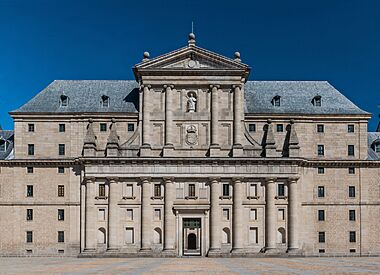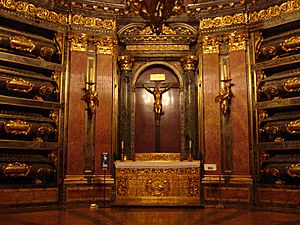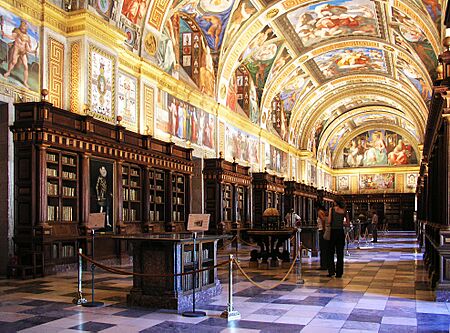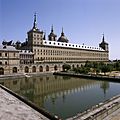El Escorial facts for kids
Quick facts for kids Royal Site of San Lorenzo de El Escorial |
|
|---|---|
|
Real Sitio de San Lorenzo de El Escorial
|
|
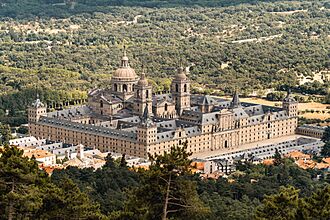
A distant view of the Royal Site
|
|
| Alternative names | Monastery of El Escorial |
| General information | |
| Architectural style | Herrerian style |
| Location | San Lorenzo de El Escorial, Spain |
| Coordinates | 40°35′N 4°09′W / 40.59°N 4.15°W |
| Management | Patrimonio Nacional |
| Design and construction | |
| Architect | Juan Bautista de Toledo |
| Official name: Monastery and Site of the Escorial, Madrid | |
| Criteria: | Cultural: (i), (ii), (iv) |
| Designated: | 1984 (8th session) |
| Reference #: | 318 |
| Region: | Europe and North America |
| Official name: Monasterio de San Lorenzo | |
| Type: | Non-movable |
| Criteria: | Monument |
| Designated: | 3 June 1931 |
| Reference #: | RI-51-0001064 |
El Escorial, also known as the Royal Site of San Lorenzo de El Escorial, is a historic home of the king of Spain. It is located in the town of San Lorenzo de El Escorial, about 45 kilometers (28 miles) northwest of Madrid. King Philip II ordered its construction, which took place between 1563 and 1584. El Escorial is the largest Renaissance building in the world.
This huge complex is one of the Spanish royal sites and serves many purposes. It is a monastery, a church (basilica), a royal palace, a royal tomb (pantheon), a library, a museum, a university, and a school.
El Escorial is made of two main parts. The first is the royal monastery itself. The second is a royal hunting lodge called La Granjilla de La Fresneda, which is about 5 kilometers (3 miles) away. Together, they showed the power of the Spanish monarchy and the importance of the Roman Catholic religion in Spain during the 16th and 17th centuries.
King Philip II hired the Spanish architect Juan Bautista de Toledo to help him design the complex. Toledo had worked on famous buildings in Italy, like St. Peter's Basilica in Rome. Together, Philip and Toledo designed El Escorial to be a symbol of Spain's role as a center of the Christian world.
In 1984, UNESCO named El Escorial a World Heritage Site. It is a very popular place for tourists to visit, with more than 500,000 visitors each year.
Contents
Why was El Escorial built?
El Escorial sits at the base of Mount Abantos. King Philip II of Spain chose this rugged location for a special reason. He wanted to build a great monument to celebrate Spain's victory over France in the Battle of St. Quentin in 1557.
Philip wanted a building that was both a palace and a monastery. He also wanted it to be a burial place for his parents, Charles I and Isabella of Portugal, as well as for himself and future Spanish royalty. Finally, he imagined El Escorial as a center for learning to support the Counter-Reformation, a movement to strengthen the Catholic Church.
The cornerstone of the building was laid on April 23, 1563. The first architect, Juan Bautista de Toledo, died in 1567. His student, Juan de Herrera, took over and finished the project in 1584. The entire construction took just under 21 years.
Since then, El Escorial has been the burial site for most Spanish kings and queens of the last 500 years.
The Design of the Building
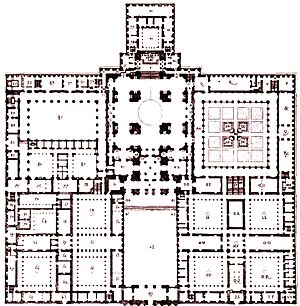
The floor plan of El Escorial is shaped like a gridiron, which is a metal grill used for cooking. Many believe this shape was chosen to honor Saint Lawrence. He was a Christian martyr who was roasted to death on a grill in the 3rd century. The Battle of St. Quentin was won on St. Lawrence's feast day, August 10.
However, some historians have other ideas. They think the design might be based on descriptions of the Temple of Solomon from ancient texts. This theory is supported by the statues of King David and King Solomon at the entrance to the basilica.
The building is made mostly of gray granite from nearby quarries. It has a simple and severe look, almost like a fortress. It is a huge rectangle, about 224 by 153 meters (735 by 502 feet). At each of the four corners, there is a square tower with a spire. In the center, the dome of the basilica rises above the rest of the complex.
King Philip's instructions to his architects were clear. He wanted "simplicity in the construction, severity in the whole, nobility without arrogance, majesty without ostentation."
Inside, El Escorial is also a massive art gallery. It holds masterpieces by famous artists like Titian, El Greco, and Velázquez.
Inside the Royal Monastery
Courtyard of the Kings and Basilica
The main entrance on the west side leads to the Courtyard of the Kings (Patio de los Reyes). The courtyard is named for the statues of the kings of Judah on the front of the basilica.
The basilica is the main church of El Escorial. It has a floor plan in the shape of a Greek cross, where all four arms are equal in length. A huge dome, inspired by St. Peter's Basilica in Rome, sits over the center of the cross. The main altarpiece at the front of the church is 30 meters (98 feet) high and decorated with bronze sculptures and paintings.
One special chapel in the basilica displays the famous Crucifix carved from white marble by Benvenuto Cellini.
Palace of Philip II and Hall of Battles
Next to the basilica is the Palace of Philip II. The rooms are decorated simply. From his bedroom, the king had a special window that allowed him to watch church services from his bed when he was sick.
Nearby is the Hall of Battles (Sala de las Batallas). Its walls are covered in fresco paintings that show important Spanish military victories.
Royal Burial Vaults
Under the basilica is the Royal Pantheon, a crypt where the kings and queens of Spain are buried. It is an octagonal room made of marble with 26 marble and bronze tombs. Almost all Spanish monarchs since Charles I are buried here.
There is also a Pantheon of the Princes. This is the resting place for princes, princesses, and royal family members who were not ruling monarchs.
The Famous Library of El Escorial
The Royal Library of El Escorial was one of the most advanced in Europe when it was built. It was the first major library to place its bookcases along the walls, which became known as the "wall system." This design allowed for better lighting and space.
The library's huge main hall is 54 meters (177 feet) long. The ceiling is decorated with beautiful frescoes showing the seven liberal arts: grammar, rhetoric, dialectic, music, arithmetic, geometry, and astronomy.
King Philip II donated his personal collection of books and sent people all over Europe to buy the finest books and manuscripts. The library grew to hold thousands of priceless works, including ancient texts in Latin, Greek, Arabic, and Hebrew.
Today, the library holds more than 40,000 volumes. It contains many important illuminated manuscripts, which are books decorated with gold and colorful illustrations.
Other Interesting Areas
- Art Gallery: This gallery contains paintings from Spanish, Italian, and other European schools from the 15th to 17th centuries.
- Architectural Museum: This museum shows the tools, cranes, and blueprints used to build El Escorial.
- Gardens of the Friars: These peaceful gardens were created for rest and quiet thought. They are still used by students at the school located within El Escorial.
Gallery
-
A painting of El Escorial by Michel-Ange Houasse from 1723
See also
 In Spanish: Real Monasterio de San Lorenzo de El Escorial para niños
In Spanish: Real Monasterio de San Lorenzo de El Escorial para niños



